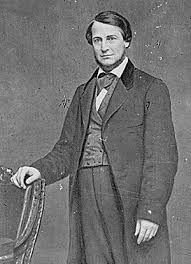As part of Daniel Farber’s book, Lincoln’s Constitution, he use s the Ex Parte Vallandigham Case of 1863 to demonstrate how Civil War military authority played a role in inhibiting free speech. This case is important to our understanding of Lincoln’s questionable Civil War era policies and the impact they had on the public.
s the Ex Parte Vallandigham Case of 1863 to demonstrate how Civil War military authority played a role in inhibiting free speech. This case is important to our understanding of Lincoln’s questionable Civil War era policies and the impact they had on the public.
In this case, former Ohio Congressman and Peace-Democrat, Clement Vallandigham delivered a speech in which “he had called the war …a war to fight abolitionism rather than to save the Union.” (Farber 171) However, the grounds for Vallandigham’s arrest was his reference to President Lincoln as “King Lincoln” and his call for support to “hurl ‘King Lincoln’ from his throne.” (Farber 171) Previous to this case, an order had been implement entitled General Order No. 38 by General Ambrose Burnside which stated that the “habit of declaring sympathies for the enemy will not be allowed” and that treason “expressed or implied” (Farber 170) was prohibited. Vallandigham was imprisoned but ultimately, Lincoln overturned Vallandigham’s arrest and instead confined him to Confederate territory. Following this, the case was brought before the Supreme Court via a writ of certiorari.
The judge that presided over this Supreme Court case was Chief Justice Salmon Chase. Under his ruling, Chief Justice Wayne delivered the statement that it held no power to issue a writ of habeas corpus to a military commission (Court Decision)
This case provides insight into the way Lincoln and other citizens viewed the First Amendment. However, Farber concludes that although these impedements on free speech may seem unnecessary, “Lincolns intuition that free speech should be suppressed only under imperative circumstances was correct.” (Farber 174) Farber uses World War I-era cases to prove the presence and confrontation of free-speech limitations through a more modern lens, the most prominent example being Debs v. United States. In this example, presidential candidate Eugene Debs openly criticized the U.S. government and the draft as a whole. Ultimately, the court sentenced him to ten years in prison. With this example in mind, Farber is reminding us that considering the extreme political situation at hand, Farber believes that Lincoln’s actions, although perhaps excessive, were justified.
This case is highlighted by several historians as one of the more notable cases of the Civil War era during the military trials that took place amidst the suspension of the writ of habeas corpus. One book, Lincoln and the Court, by Brian McGinty highlights many of miltiary trials that took place during the Lincoln administration that brought the First Amendment into question. However, McGinty also addresses some fundamental problems that the judicial system was having at the time concerning reorganization. This structural disarray placed more stress on the same Supreme Court judges who were dealing with the effects of a sectional war. A review in the Yale Journal of Law of McGinty’s book, entitled “Lincoln and the Court” as well, by R. Owen Williams cites that McGinty “successfully demonstrates that the Civil War was essentially a legal struggle with the Supreme Court at its core.”
Another resource that helps to shed light on this Supreme Court case and where the question of constitutionality and Lincoln’s perspective on it comes into play is in a public letter written to Ohio Democrats, namely Matthew Birchard, justifying his wartime decisions called “The Birchard Letter“. This letter is relevant in that Lincoln offered to release Vallandigham back to his home state should a majority of the letter’s recipients vow that “an army and navy are constitutional means for suppressing that rebellion” and that none will “tend to hinder the increase, or favor the decrease, or lessen the efficiency of the army or navy.” Lincoln also used this letter as a means to justify his wartime decision and claimed that “by the constitution the benefit of the writ of Habeas corpus itself may be suspended when in cases of Rebellion or Invasion the public Safety may require it.” However, Lincoln also acknowledged his dissenters and went on to say that although the Constitution does not specifically grant one single person the power to make decisions during wartime, it is implied that “the man whom, for the time, the people have, under the constitution, made the commander-in-chief, of their Army and Navy, is the man who holds the power, and bears the responsibility.” This 2,000 word letter provides a clear and detailed argument for Lincoln’s stance on the constitutionality of his decisions, and is a valuable resource in understanding the effects of the Vallandigham case.
These sources give readers of this case insight into the meaning behind the Vallandigham case and what roles the First Amendment, civil war tensions, judicial stress, and Lincoln’s interpretation of constitutionality play in this important Supreme Court decision.
